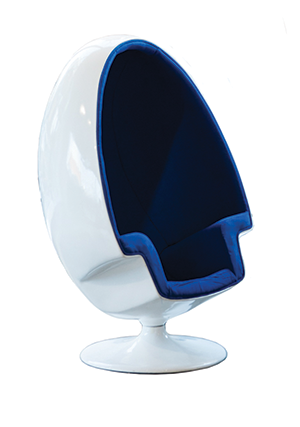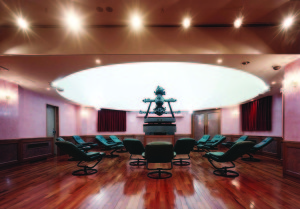Scanning the Cosmic Buddha
The secrets of a limestone Buddha sculpture from the 6th century are being uncovered with the help of 3D technology. Though headless and handless, the life-size statue has been identified by art historians at Washington D.C.’s Sackler and Freer galleries as Virochana, the generative force behind all phenomena in the universe according to Buddhist texts. The robes of the “Cosmic Buddha,” which were once elaborately painted, are covered with dozens of intricate illustrations portraying the historical Buddha’s life and teachings.
Until recently, scholars and researchers have used paper rubbings to see the Cosmic Buddha’s detailed images more clearly. But this process threatened to wear down the statue’s surface, so in 2011, a team took digital scans of the sculpture, stitched them together, and created a virtual 3D model. An interactive, web-based version is now available to the public both inside and outside the gallery, so that viewers can go online to examine the sculpture, rotate it, adjust lighting, and zoom in for a closer look. The platform also features a guided tour from the Sackler and Freer’s curator of ancient Chinese art.
Readers in the D.C. metro area can see the Cosmic Buddha in stone at the exhibit “Body of Devotion: The Cosmic Buddha in 3D” through December 2016. The rest of us can act as amateur archaeologists from the comfort of our laptops by following this link.
Mr. Monk Delivery
We all know that you can get everything you want from Amazon.com, but until recently that “everything” didn’t include a Buddhist monk. For better or worse, now it does. Amazon Japan has introduced “Obo-san bin,” or “Mr. Monk Delivery,” allowing its customers to order a monk-to-go for their ceremonial needs. Memorials, funerals, and more are offered at a fraction of the cost charged by a traditional Buddhist temple; for $300 the basic plan will cover the service of a monk, his transportation, and a donation. (Upgrades that cover events in more than one location and other services are also available.) The company that offers the deliver-a-monk service through Amazon says that demand has tripled over the past five years, and with many of Japan’s 75,000 temples struggling to sustain business, it’s only natural that monks are looking for new ways to earn a living. Of course, not everyone is pleased. But it might be only a matter of time before the rest of the world catches on. Japan, as usual, is simply ahead of the curve.
Thou Shalt Not Snorkel
Do monks dream of coral reefs? Apparently, yes. But may they snorkel? A group of Buddhist monks were spotted onboard a sightseeing ship near the island of Koh Laoya, Thailand, as they prepared to go for a swim. The boat’s captain was aware that it was inappropriate for monastics to engage in recreational activities and had taken them to a secluded spot in the bay, but that didn’t protect the water-loving monks from being spotted, snapped, and posted to Facebook. The snapshot found its way to the Office of National Buddhism, an organization mandated to promote Buddhist affairs—and to reprimand monks who get out of line. The head of the regional office, Santi Dinmuang, issued an official clarification: swimming in coral reefs is forbidden, if you’re a monk.

Virtual Meditation
Do you ever feel overwhelmed or stressed, or find it difficult to relax? Do you have some space in your living room that you’ve been looking to fill with an egg-chair-cum-virtual-reality device? Cigna hopes you’re not the only one.The global healthcare giant recently released a prototype of its virtual relaxation pod to the public for testing. Instead of sitting down on a meditation cushion, users sit back in the pod’s cozy-looking interior, strap on the Oculus Rift VR headset, and select a two-minute rejuvenating scene in which to bliss out. Options include a Zen garden, a tropical beach, and a wooded campsite. While wearing the headset, users can look around their 3D environment, which showcases details like shifting skies, flowing water, wind, and foliage. An “expert-led” audio meditation accompanies the visual experience.
The company says that the pod was developed to promote mindfulness and lower the expense of stress-related illnesses, which cost the U.S. economy more than $300 billion a year. Virtual reality technology has already been used to help patients overcome phobias, quit smoking, manage pain, and recover from PTSD and depression.
What we’d like to ask is: is there a point to a pod that treats the symptoms of stress while ignoring its root causes? The jury’s out for now.

To Enlightenment . . . and Beyond!
Is there a link between Buddhist thought and space? An emphasis on emptiness, maybe? A potential for enlightenment? Might there be a correlation between seven-point meditation posture and the Seven Sisters of the Pleiades?
No, none of the above, says Ryo Kasuga, the Buddhist priest behind the Planetarium Theatre Galaxy at Shoganji, a 400-year-old temple in Tokyo that is the only one in the world to feature a planetarium on its grounds. Kasuga outfitted the facility in 1996 by collecting donated technology from organizations that no longer needed their equipment.
As you may have guessed, Kasuga is no ordinary priest. As a young man he left Japan to study operatic singing in Italy; he returned home to take up the position of head monk of Shoganji temple in the wake of his father’s passing. He agreed to lead, however, only under the condition that he be permitted to revolutionize the way the temple taught Buddhism. He uses the wonders of the planetarium—the stars, planets, and the depths of space—to draw interest to the temple, then gives visitors a lecture on topics both Buddhist and cosmological.
Read our interview with Ryo Kasuga here.
Thank you for subscribing to Tricycle! As a nonprofit, we depend on readers like you to keep Buddhist teachings and practices widely available.